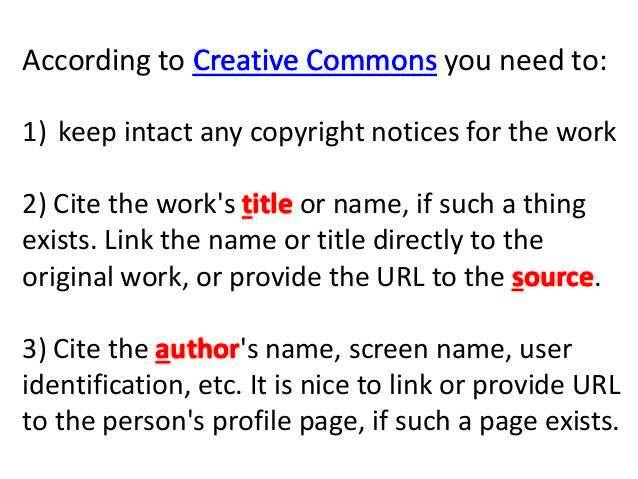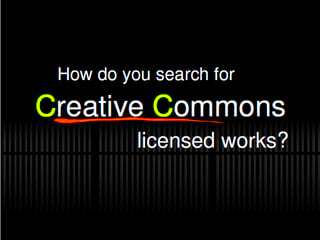Copyright is a legal term that protects original works, including images, music, literature, and more. When you create something, you automatically hold the copyright to it. This means you have exclusive rights to use, share, and modify your work. Understanding copyright is crucial, especially in a world where sharing and accessing content online is so easy. If you want to use someone else’s work, you must get their permission or ensure you’re following the copyright rules that apply.
Here are a few key points about copyright:
- Ownership: The creator of the work owns the copyright unless they transfer it.
- Duration: Copyright lasts for the life of the creator plus a number of years, usually 70 years.
- Fair Use: Some limited use of copyrighted material is allowed without permission, like for criticism or education.
Importance of Crediting Images

Crediting images is vital for several reasons. It shows respect for the creator's work and helps maintain ethical standards in content creation. When you credit an image, you acknowledge the effort and creativity of the original artist. This is not just a courtesy; it’s often a legal requirement to avoid copyright infringement.
Crediting images can also:
- Build Trust: Viewers appreciate transparency about where content comes from.
- Enhance Your Reputation: Properly credited images reflect professionalism and respect for copyright.
- Avoid Legal Issues: Failing to credit images can lead to copyright claims and financial penalties.
Also Read This: How to Promote Your Shutterstock Portfolio on LinkedIn: A Comprehensive Guide
How to Credit Images Properly
Properly crediting images can vary based on the source and licensing agreement. Here are some general guidelines to follow:
1. Identify the Creator: Find out who created the image. This could be an individual or an organization.
2. Check the Licensing Agreement: Understand the terms under which the image can be used. This often comes from the website where you found the image.
3. Format Your Credit: A typical image credit includes the creator’s name, the title of the work, and the source. Here’s a basic format:
| Format | Example |
|---|---|
| Creator Name | Photo by John Doe |
| Title | Sunset Over the Mountains |
| Source | From Unsplash |
4. Place the Credit Appropriately: Usually, the credit goes directly below the image or at the end of your content.
By following these steps, you ensure that you respect the rights of the original creators and maintain the integrity of your own work.
Also Read This: Shutterstock Free Download Without Watermark – Your Ultimate Solution to High-quality Images!
Common Mistakes to Avoid When Crediting Images
Crediting images may seem straightforward, but there are common pitfalls that many people fall into. Avoiding these mistakes can help you respect copyright laws and support artists. Here are some frequent errors to watch out for when crediting images.
1. Incomplete Credits: Always provide full credit. Missing the creator's name or source can lead to confusion and potentially legal issues.
2. Incorrect Attribution: Double-check the spelling of the creator's name and the title of the work. Mistakes can undermine the creator's rights.
3. Not Following Licensing Terms: Different images have different licensing agreements. Make sure you understand what’s required for each image.
4. Crediting the Wrong Person: If an image is shared widely, it might be misattributed. Always trace back to the original creator.
5. Using Images Without Permission: Even with a credit, some images require explicit permission to use. Always check the licensing first.
By steering clear of these mistakes, you can help maintain a respectful and lawful approach to using images in your projects.
Also Read This: How to Convert RAW Images to JPEG Format: A Beginner’s Guide
Using Creative Commons Images
Creative Commons (CC) images are a great resource for finding free content that you can use legally. These images come with licenses that allow creators to share their work under specific conditions. Understanding how to navigate these licenses is key to using Creative Commons images correctly.
Here are the main types of Creative Commons licenses:
- CC BY: Allows use, distribution, and modification with proper credit.
- CC BY-SA: Same as CC BY, but modified works must be shared under the same license.
- CC BY-ND: Allows use without modification, with credit.
- CC BY-NC: Non-commercial use only, with credit required.
- CC BY-NC-SA: Non-commercial use, sharing under the same license.
- CC BY-NC-ND: The most restrictive, allowing only non-commercial use without modification.
When using Creative Commons images, always:
- Read the license carefully.
- Provide proper attribution according to the license terms.
- Check if you can modify the image.
Also Read This: Maximizing Discoverability on 123RF: Tips for Increasing Exposure
Stock Image Websites and Licensing
Stock image websites offer a treasure trove of images for various projects, from blogs to marketing materials. However, understanding their licensing structures is crucial to avoid misuse and ensure compliance.
Here’s a look at common stock image licenses:
| License Type | Description |
|---|---|
| Royalty-Free | One-time payment for unlimited use, but cannot claim ownership. |
| Rights-Managed | Pricing based on how the image will be used. Usage rights are limited. |
| Extended License | Allows for more uses, including merchandise, but usually at a higher cost. |
| Creative Commons | Free to use under specified conditions, as mentioned earlier. |
Before downloading images from stock sites:
- Review the licensing agreement carefully.
- Ensure you understand any restrictions on use.
- Credit the photographer if required by the license.
By familiarizing yourself with these licenses and following the guidelines, you can make the most of stock images while respecting the rights of their creators.
Also Read This: A Comprehensive Guide to Earning Money from Dailymotion Videos
Benefits of Proper Image Credit
Giving proper credit for images is not just a courtesy; it has several important benefits for both creators and users. When you credit images correctly, you contribute to a culture of respect and professionalism. Let’s explore some key advantages of proper image credit.
1. Supports Creators: When you credit artists, you recognize their hard work. This encouragement helps them continue creating and sharing their art.
2. Enhances Your Credibility: Using credited images shows that you take copyright seriously. It builds trust with your audience, as they can see you value original content.
3. Reduces Legal Risks: Properly crediting images minimizes the chances of copyright infringement claims. This is crucial in avoiding legal troubles that can arise from using images without permission.
4. Encourages Community Sharing: When you credit creators, you help spread awareness of their work. This can lead to more sharing and collaboration within creative communities.
5. Improves SEO: Search engines value original content and proper attributions. Crediting images can enhance your website's visibility, attracting more visitors.
By understanding and embracing these benefits, you can create a more ethical and supportive online environment for everyone involved.
Also Read This: Creating ISO Images from Files for Backup
FAQ
Have questions about image crediting? Here are some common queries and their answers to help clarify the process:
Q: Do I always need to credit images I use?
A: Yes, unless the image is in the public domain or you have explicit permission from the creator not to credit.
Q: What if I can't find the creator's name?
A: Try to trace the image back to its source. If you still can't find the creator, it’s best not to use the image.
Q: Can I modify an image if I credit it?
A: It depends on the license. Always check the terms to see if modifications are allowed.
Q: Are there free resources for finding images?
A: Yes, many sites offer free images with Creative Commons licenses or royalty-free options. Just ensure to follow their crediting guidelines.
Conclusion
In conclusion, crediting images correctly is crucial in today’s digital landscape. It not only shows respect for the creator's rights but also enhances your credibility and reduces the risk of legal issues. By understanding copyright basics, knowing how to credit images, and avoiding common mistakes, you can create a more ethical and supportive environment for all creators.
Remember, every time you use an image, you have the opportunity to acknowledge the hard work of artists and build a community that values creativity. So, let’s make a habit of giving credit where it's due and help foster a culture of respect and collaboration in the creative world.

 admin
admin








